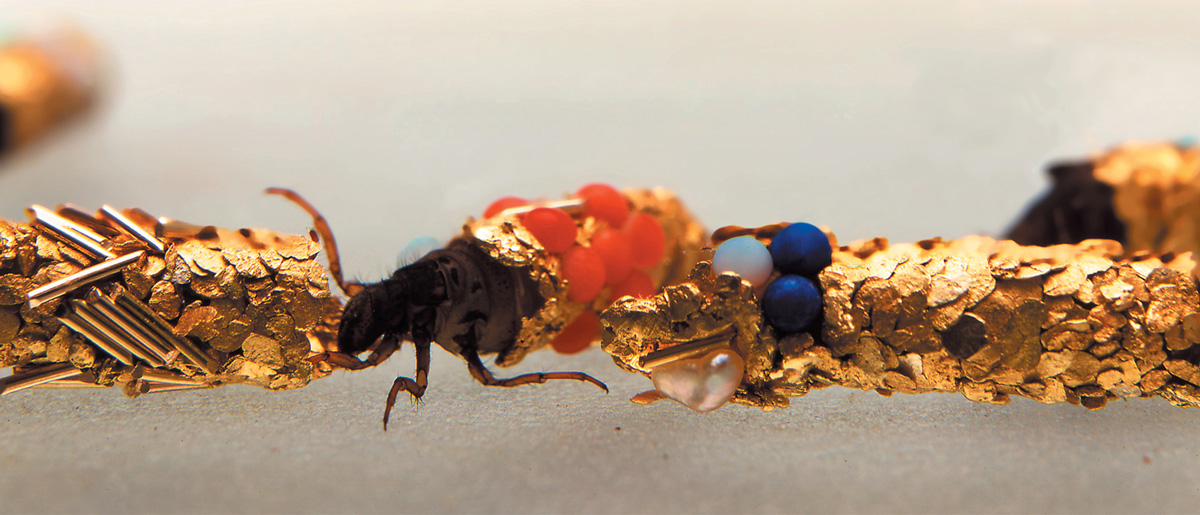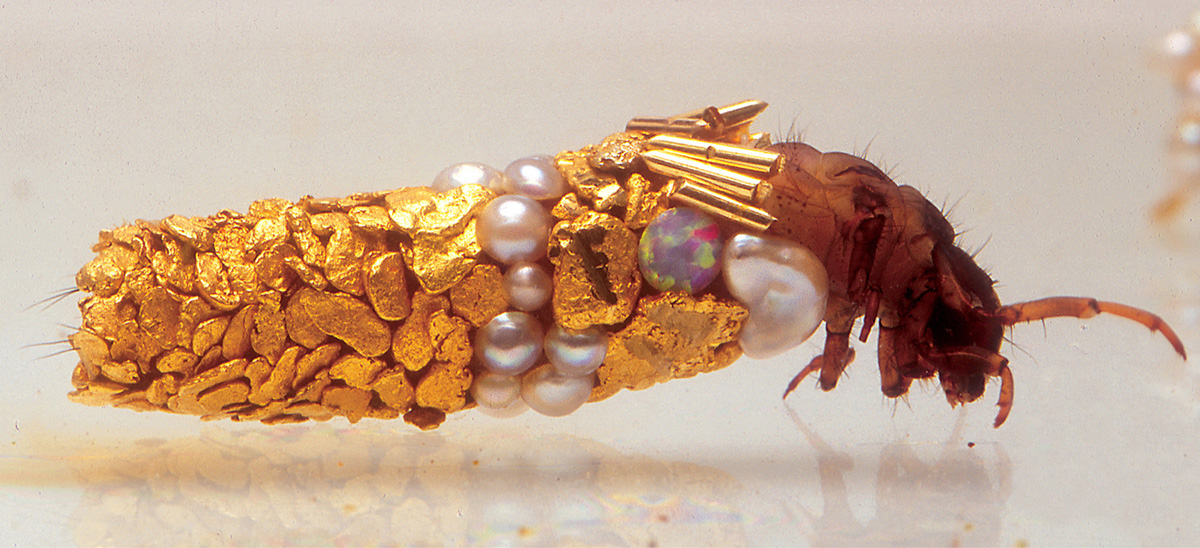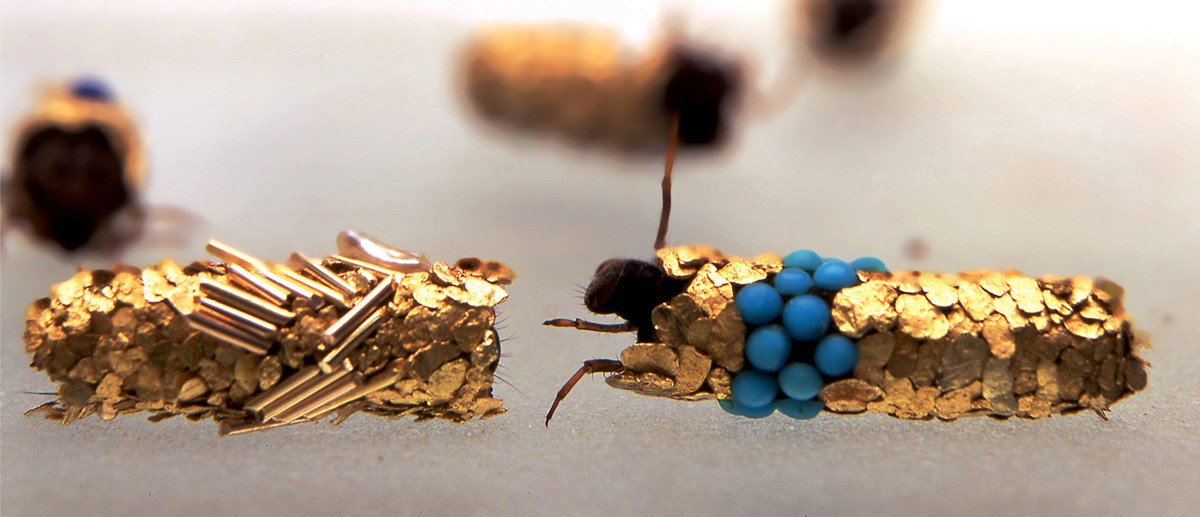Artist Project / Trichopterae
Bug bling
Hubert Duprat



The images above illustrate the results of an unusual artistic collaboration between the French artist Hubert Duprat and a group of caddis fly larvae. A small winged insect belonging to the order Trichoptera and closely related to the butterfly, caddis flies live near streams and ponds and produce aquatic larvae that protect their developing bodies by manufacturing sheaths, or cases, spun from silk and incorporating substances—grains of sand, particles of mineral or plant material, bits of fish bone or crustacean shell—readily available in their benthic ecosystem. The larvae are remarkably adaptable: if other suitable materials are introduced into their environment, they will often incorporate those as well.
Duprat, who was born in 1957, began working with caddis fly larvae in the early 1980s. An avid naturalist since childhood, he was aware of the caddis fly in its role as a favored bait for trout fishermen, but his idea for the project depicted here began, he has said, after observing prospectors panning for gold in the Ariège river in southwestern France. After collecting the larvae from their normal environments, he relocates them to his studio where he gently removes their own natural cases and then places them in aquaria that he fills with alternative materials from which they can begin to recreate their protective sheaths. He began with only gold spangles but has since also added the kinds of semi-precious and precious stones (including turquoise, opals, lapis lazuli, and coral, as well as pearls, rubies, sapphires, and diamonds) seen here. The insects do not always incorporate all the available materials into their case designs, and certain larvae, Duprat notes, seem to have better facility with some materials than with others. Additionally, cases built by one insect and then discarded when it evolves into its fly state are sometimes recovered by other larvae, who may repurpose it by adding to or altering its size and form.
Duprat traces his work with the caddis fly larvae back to pioneering nineteenth-century entomologists such as François-Jules Pictet and Jean-Henri Fabre, who both conducted experiments in which structure-building insects were given alternative, non-indigenous materials. Seen within the context of the artist’s work—a practice that has often addressed aspects of mimesis in the realms of both nature and facture through his conceptual sculptural activities—the caddis fly larvae project is an example of Duprat’s ongoing interest in productive collisions between organic forms and technologized materials. Yet the work also provokes broader philosophical questions regarding behavior and intent, one that was summarized particularly astutely by the critic and philosopher Christian Besson, in a conversation with the artist conducted in the late 1990s:
Kant’s distinction between works of art and those of nature leaves us in a quandary. The production of the artifact within nature herself poses a problem—even more so when an aesthetic aspect is involved. Whether the insect is a craftsperson or whether, more generally, nature is a creator of forms, the consideration, within nature, of an aesthetic dimension is the stumbling block of science. ...
Your activity as an artist, upsetting the ordinary ethology of the insect, seems to me to be the same thing as introducing a noise, complicating its umwelt and producing a response. In your diversion of the caddis worm’s behavior, in your artistic manipulation, the effect is twofold. From a biological viewpoint, a random event triggers self-organization. From a human viewpoint, the experimenter’s intent produces this effect. ...
Is the caddis worm’s precious case the work of the insect or the work of the artist? This is not the right question. The contradiction can be resolved by the differing viewpoints. According to the first view, the caddis worm owed nothing to the artist (who is simply the author of one noise among the thousands of other noises in its environment). According to the second view, the caddis worm is merely the executor of the artist’s project. The artistic statement plays on the confusion of the two levels by overlaying the two perspectives. The aesthetic result (at once natural and artistic) turns the caddis worm’s case—which is more than an assisted ready-made or a diversion—into a doubly exposed object...[1]
—Jeffrey Kastner
To watch Duprat’s larvae in action, click here. (0.9 MB).
See press about this project on mining.com.
- Christian Besson in conversation with Hubert Duprat, from “The Wonderful Caddis Worm: Sculptural Work in Collaboration with Trichoptera,” translated by Simon Pleasance, in Leonardo, vol. 31, no. 3, June–July 1998.
Hubert Duprat is an artist living in the south of France. He is currently at work on several public projects that include stained-glass windows, a grotto, and a tunnel. He is also preparing a monograph on Trichopterae. Recent publications include Hubert Duprat Theatrum by Christian Besson (R.M.N, 2002) and Une oeuvre de Hubert Duprat (Editions Muntaner, 2007).
Spotted an error? Email us at corrections at cabinetmagazine dot org.
If you’ve enjoyed the free articles that we offer on our site, please consider subscribing to our nonprofit magazine. You get twelve online issues and unlimited access to all our archives.